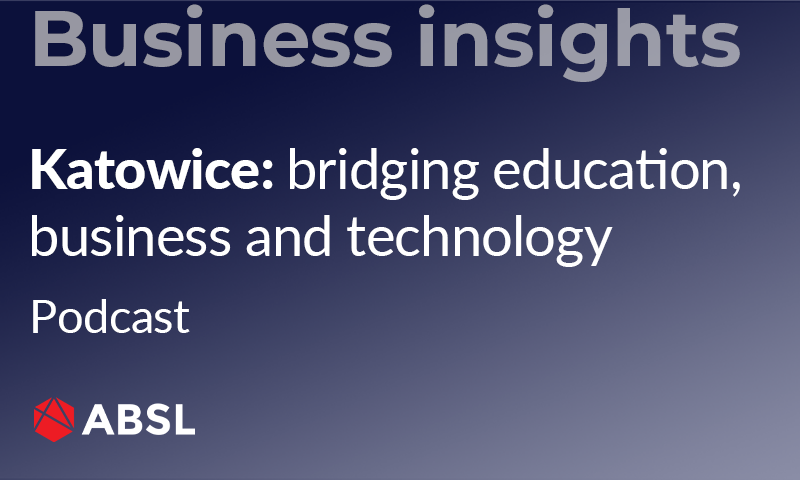Work environment for the post-pandemic times: Colliers presents the latest report on implemented and planned changes in the business services sector (BSS)
The COVID-19 pandemic continues to affect our professional and private lives to an unprecedented degree, changing many aspects of the way businesses and public sector services operate. In its latest report "Defining the New. New work models and approaches in the BSS sector" Colliers presents the results of a survey conducted among 76 members of the Association of Business Service Leaders (ABSL) – executives from the BSS sector.
The questions asked in the survey concerned the impact of changes in the work environment caused by the pandemic on perceived employment and productivity, financial issues and office space, health and safety measures, various aspects of employee wellbeing, future talent and location strategies. The survey also examined the challenges that BSS companies are facing today as well as the opportunities and concerns for the future.
BSS opts for a hybrid model
Nearly 71% of the survey respondents indicated that their organisation currently deploys a hybrid work model - 74% was already working in this model or had already been practicing some form of remote working before the pandemic. Where hybrid model has been introduced, nearly 72% declare that their employees spend on average 4 days per week working remotely. Due to the uncertainty of the epidemic situation and the specter of further lockdowns, nearly 70% of companies have not yet decided to return to the office.
Among organisations working fully remotely or fully on-site during the pandemic, as many as 82% would like to implement a hybrid model; only 14% have no plans to do so. As far as the scope of remote work is concerned, the most popular model is 50%-50% of time split between office and remote setting.
However, relatively few companies decide to define the rules and scope of remote work at the organisational level - it will be determined mainly by managers or employees themselves. The vast majority of respondents rate their organisation's readiness to implement the hybrid model as moderate or high, with only 6% rating it as very poor. However, this does not mean that the introduction of the new model will not involve many challenges for companies.
“An organisation is much more than a collection of individuals performing specific tasks. One of the key areas requiring attention will therefore be to ensure that the organisation retains cohesiveness on a social level - maintaining sense of belonging among dispersed employees. Many studies conducted during the pandemic have also revealed work-life balance disruption. Working from home blurs the boundaries between work and home. The inability to turn off the computer and leave the office makes us work more, often until late hours. The aforementioned phenomena have a direct impact on employee engagement, and the willingness to stay with the company. Organisations will therefore need to prepare to deal with these challenges by implementing appropriate initiatives and constantly monitoring the situation. Success will be less determined by what model of work will be implemented, and more by how well the organisation is prepared for this change - through appropriate training for leaders in managing a dispersed team,” said Grzegorz Rajca, organisational psychologist, Senior Associate, Workplace Innovation, Colliers.
As the top challenges for organisations when working remotely, respondents strongly pointed to maintaining a sense of belonging among employees (83%), followed by maintaining work-life balance (52%), onboarding new employees (35%), ongoing management of teams (32%) and ensuring a smooth exchange of information within the company (30%).
The transformation of office space
The results of the survey showed that the share of organisations that decided to implement changes in office space during the pandemic, and those that did not make such changes, was evenly distributed. 33% of companies that have implemented these changes, decided to reduce space or implement hot desking, 28% fully redesigned the office space, whereas 23% increased the variety of spaces offered to employees. 39% of organisations that haven't made any changes yet plan to introduce them in the near future, while 28% haven't made a decision yet. As many as 81% of organisations are encouraging or planning to encourage employees to return to the office, and adapting the office space to new conditions, e.g. by introducing flexible solutions, may be one of the most important arguments in this process.
“The new reality has emphasized that flexibility is crucial in totally unpredictable and uncertain times - it plays also a significant role in building a real estate portfolio strategy. What’s important, with the right approach, a flex leasing can almost instantly adapt to the current needs of the client and operators of such space are becoming increasingly open to more non-standard solutions,” said Jakub Bartoszek, Director of Flexible Strategy Advisory, Colliers.
Is the world of talent wide open?
Talent strategy related issues – from attraction and retention through performance and skills development to wellbeing, remain at the forefront of strategic concerns for most organisations. One of the major changes COVID-19 has made to the dynamic of the talent war is reducing the importance of geographic constraints. This brings both opportunities and risks.
“Employers who offer remote-only or remote-first positions can access a much wider pool of talent, often in a relatively cost-effective manner. However, managing dispersed workforce effectively requires a major effort of transforming processes and practices, something not every organisation is ready for. Employees who are able and equipped to work remotely have access to broader range of opportunities, but also face increased global competition. The situation further contributes to an already prominent gap between those who possess the most desirable skills and those who are simply reasonably good at their profession, further widening the salary gap and compounding income inequality problems,” said Dorota Osiecka, Director of Workplace Innovation, Colliers.
Colliers survey results show the importance of talent war for organisations - 71% of companies indicated the retention of key talent and 68% - attracting best employees as the main challenges facing their organisations in the coming year. A solution to these challenges may be a change in hiring and location strategy that has already begun to be implemented during the pandemic. Over 75% of the respondents who had only office-based employees before the pandemic consider some form of remote work to be allowed either anywhere in Poland (30%) or within commuting distance from the office location (46%). Together with the companies that allowed remote work before, this adds up to a total of nearly 85% of respondents who allow some form of remote work. In addition, over 40% of the companies allow remote work from locations beyond the commuting distance from the office location.
“This is a trend that will heavily impact location strategies in the upcoming years. The talent search has crossed the borders of cities, regions and sometimes even countries. Kraków is already expanding its talent pool with specialists from Tarnów, Łódź, Katowice or even Lviv. By utilizing this opportunity, companies located in cities with overheated labour markets can be more competitive when fighting for new projects. Newcomers can benefit from the infrastructure and highly skilled talent of the mature markets and an easily accessible remote workforce,” said Jan Kamoji-Czapiński, Associate Director in EMEA Location Strategy, Colliers.
Employee health and wellbeing as a priority for organisations
The COVID-19 outbreak has highlighted the key role buildings play in affecting people’s health and wellbeing. Although the vast majority of companies (96% of respondents) reported that they had implemented measures to prevent the spread of SARS-COV-2 affecting their employees, such as travel restrictions, increased hygiene rules, remote working, etc., or had introduced dedicated office management applications (62% of respondents), a large number of measures also focused on supporting employees’ wellbeing. A significant number of organisations have introduced regular one-to-one meetings and catch-up sessions (79%), regular training sessions e.g. on stress management (64%) or mental health counseling (63%). 56% of companies also encourage their teams to get vaccinated - mainly through internal communication (28%), joining the workplace vaccination program (26%), giving employees paid time off work to get vaccinated (18%) or providing the opportunity to get vaccinated at the workplace (13%).
Increasing workplace safety requirements are putting significant pressure on office managers to ensure reduction of the epidemic spread, but also maximize the comfort and trust of occupiers during the “back to normal” procedures. The new pandemic certification systems for buildings and spaces such as the WELL Health Safety Rating have emerged as a response to these market demands.
“Several recommendations have been issued based on the collected best practices and scientific studies, as well as several good practices were developed and implemented, most of which focused on indoor air quality, cleaning and sanitization, healthcare resources and emergency preparedness programs,” said Andrzej Gutowski, Associate Director, Green Building Certification, Colliers.
“The analysis of the survey results shows that adapting the work environment and model to the post-pandemic times is a major challenge for companies. It also includes measuring the impact of these changes on the organisation's business performance. Most companies are forced to make key decisions under conditions of high uncertainty. Therefore, the best strategy would be to approach this as a carefully crafted experiment. In addition to periodic monitoring of clearly defined business KPIs, regular measurements of vital indicators of organisational health should be planned for. These include the level and quality of team interactions and collaboration, individual work-life balance, or employees’ wellbeing. This will enable organisations to understand the real impact of new work models on their workforce and business outcomes, and to determine the right course of action or to spot red flags early,” said Dorota Osiecka.









